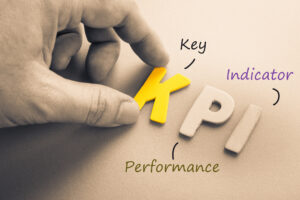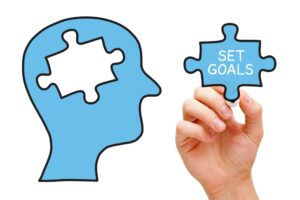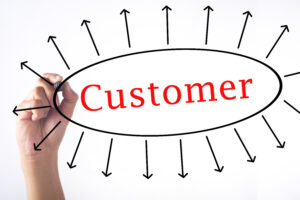Making the most of sales data and insights
There is a lot of talk about the increasing importance of sales data. In a recent workshop with sales enablement professionals, we considered the different ways of approaching sales data.
The keys to success seem to be:
Make it as easy as possible to gather the data. Automate where possible and don’t place heavy burdens on salespeople.
Make sure that the data that is captured is useful to the users – salespeople, sales managers, sales leaders…
Be as transparent as possible. A culture of sharing sales insights from data generates, cross-learning and greater co-operation.
Here are some options for recording, reporting and communicating sales data:
Key Performance Indicators (KPIs):

Some good Sales KPIs
Sales Revenue: Total income from B2B sales.
Customer Acquisition Cost (CAC): Cost associated with acquiring a new B2B customer.
Customer Retention Rate: Percentage of customers who continue to do business over a specific period.
Cross-sell & upsell rates: Increased sales from existing customers (existing and new products)
Average Deal Size: The average revenue generated per sale.
Sales Cycle Length: The average time it takes to close a sale.
Sales activity levels: Number of sales contacts. Could be split by face-to-face v remote.
Number of new sales approaches: How many new opportunities have been created/opened up?
Lead Conversion Rate: Percentage of leads that convert into actual sales.
Sales growth rate: Increase in sales over a given period e.g. year-on-year, comparable quarter/month, rolling 12 month increase.
Key Performance Indicators (KPIs) are quantifiable metrics used to evaluate the success of an organisation, employee, or process in achieving specific objectives. KPIs provide a clear framework for measuring progress and performance by highlighting critical areas of operation that directly impact strategic goals. They help in identifying strengths, weaknesses, and trends, enabling informed decision-making and continuous improvement.
Objectives and Key Results (OKRs):

Some examples of sales-related OKRs.
Objective: Increase market share in the pharma industry.
- Key Result 1: Acquire 30 new pharma industry clients by the end of Q3.
- Key Result 2: Increase average deal size by 15% within six months.
- Key Result 3: Reduce sales cycle length from 100 to 85 days by Q4.
An OKR consists of a clear, inspiring objective and a set of measurable key results that indicate progress towards that objective. This methodology promotes alignment, focus, and engagement by ensuring everyone works towards common goals. OKRs are typically set at various levels within an organisation, from company-wide objectives to individual goals, fostering transparency and accountability. They are reviewed regularly to assess progress, encourage continuous feedback, and adapt to changing priorities.
ACE

A simple approach developed by Sales Fitness Group is based on the realisation that we really only have three levers we can pull to create sales growth:
Activity levels: Measure the number of sales contacts or the proportion of time spent selling actively. Use this data to increase sales activity by e.g. reducing number of non-sales meetings in active selling time…
Concentration of effort: Measure where salespeople are spending their time: the right organisations; the right points of contact; the right products/services.
Effectiveness: Measure e.g. conversion ratios, order size, selling lag times and the skills and knowledge that underpin these.
Balanced Scorecard
A Balanced Scorecard is a strategic management tool that provides a comprehensive view of an organisation’s performance by measuring key areas beyond traditional financial metrics. It encompasses four primary perspectives: financial, customer, internal business processes, and learning and growth. By integrating these diverse aspects, the balanced scorecard helps organisations align their activities with their vision and strategy, improve internal and external communications, and monitor performance against strategic goals. This holistic approach ensures that organisations not only focus on short-term financial outcomes but also invest in long-term capabilities and customer satisfaction, fostering sustainable growth and success.
- Financial Perspective: Increase quarterly B2B sales revenue by 10%.
- Customer Perspective: Improve customer satisfaction score by 15%.
- Internal Business Processes: Reduce lead response time to within 24 hours.
- Learning & Growth: Train the sales team on advanced CRM tools by Q2.

SMART Goals:

Specific: Close 30 new B2B contracts with companies in the healthcare sector.
Measurable: Track the number of new contracts signed.
Achievable: Based on current market trends and team capacity.
Relevant: Aligns with the company’s strategy to expand in the healthcare industry.
Time-bound: Achieve this within the next six months.
Value-Based Management (VBM):
Value-Based Management (VBM) is a management approach centered around creating maximum value for stakeholders. It involves making strategic decisions that increase the overall worth of the organisation, prioritizing initiatives and investments that enhance stakeholder value. VBM integrates financial metrics with strategic planning and performance measurement, ensuring that all levels of the organisation are aligned with the goal of value creation.
This approach emphasizes long-term value over short-term profits, encouraging managers to focus on sustainable growth, efficient capital allocation, and continuous improvement in operations and market positioning. By embedding value creation into the corporate culture, VBM helps organisations achieve superior financial performance and competitive advantage.
Examples:
- Focus on increasing the overall value delivered to B2B customers, such as by improving product quality or enhancing service offerings, to justify premium pricing and enhance long-term relationships.
- Demonstrate value added to both customer and the business and demonstrate the business case.
- Measure the increase in Customer Lifetime Value.

360-Degree Feedback:

Gather feedback from sales team members, B2B clients, peers, and supervisors to identify strengths and areas for improvement in the sales process and customer interactions.
Net Promoter Score (NPS):

Regularly survey B2B clients to determine their likelihood of recommending the company to others, using their feedback to improve services and address any concerns.
Note that NPS has come under challenge recently and needs to be applied carefully, especially in B2B sales.
Lean Metrics:
In B2B sales, lean metrics can be applied to streamline the sales process, enhance efficiency, and improve customer satisfaction. Key metrics such as cycle time, lead time, throughput, and work-in-progress (WIP) help identify bottlenecks and inefficiencies in the sales pipeline. For instance, cycle time measures the duration from initial contact to closing a deal, highlighting areas where the process can be sped up. Lead time tracks the time from lead generation to conversion, aiding in better resource allocation and forecasting. Throughput measures the number of deals closed within a specific period, reflecting the sales team’s productivity. Monitoring WIP helps manage the volume of active deals, ensuring the sales team is not overloaded, which can impact performance and customer interactions. By focusing on these lean metrics, B2B sales teams can optimize their processes, reduce waste, and deliver greater value to clients, ultimately leading to increased sales and customer loyalty.

Cycle Time: Measure the time from initial contact to finalizing the sale.
Lead Time: Track the time from generating a lead to closing the deal.
Throughput: Monitor the number of sales closed within a specific period.
Customer Lifetime Value (CLV):
Customer Lifetime Value (CLV) is a key metric that estimates the total revenue a business can expect from a single customer over the duration of their relationship. CLV helps companies understand the long-term value of their customers, guiding decisions on marketing spend, customer acquisition, and retention strategies. By analysing CLV, businesses can identify their most profitable customer segments, tailor their offerings, and enhance customer experiences to maximize profitability. This metric also supports strategic planning by highlighting the potential return on investment from customer-focused initiatives, ensuring that resources are allocated efficiently to foster loyalty and drive sustainable growth.
Calculate the total value a B2B customer is expected to bring over the entire relationship, helping to prioritize high-value clients and tailor strategies to enhance their lifetime value.

- Measure average longevity and average order value.
- Apply this to both gross and net sales (volume and margin)
- Compare CLV with CAC (Client acquisition cost)
Social Return on Investment (SROI):
Assess the broader impact of B2B sales activities, such as how the products or services sold contribute to the social, environmental, and economic goals of the client businesses.

Project Management Metrics:
Use metrics like Earned Value Management (EVM) to track the performance and progress of large B2B sales projects, ensuring they stay on time and within budget.
Agile Metrics:
Agile metrics can provide valuable insights into the sales process’s efficiency, effectiveness, and adaptability, helping sales teams to iterate and improve continuously. These metrics include lead time, which measures the duration from lead generation to deal closure, and velocity, which tracks the number of deals closed within a specific period. Additionally, conversion rates at various stages of the sales funnel and customer feedback scores are essential agile metrics. By regularly reviewing these metrics, sales teams can identify bottlenecks, assess the impact of changes, and adjust strategies promptly. This iterative approach allows for rapid response to market dynamics and customer needs, fostering a more responsive and successful sales process.
Examples:
Velocity: Measure the amount of work (e.g., number of calls) completed in a sprint (typically 2-4 weeks).
Burndown Charts: Track the progress of sales activities against the targets set for a specific period.
Lead Time: Measure the time it takes to move leads through the sales pipeline from start to finish, continuously seeking ways to reduce this time.
Conclusions
Basing decisions on data rather than guesswork can radically improve sales effectiveness and efficiency.
The danger is that we create a whole industry out of sales data.
Keep in mind the keys to success we described at the start of this article.
· Make it as easy as possible to gather the data. Automate where possible and don’t place heavy burdens on salespeople.
· Make sure that the data that is captured is useful to the users – salespeople, sales managers, sales leaders…
· Be as transparent as possible. A culture of sharing sales insights from data generates, cross-learning and greater co-operation.

